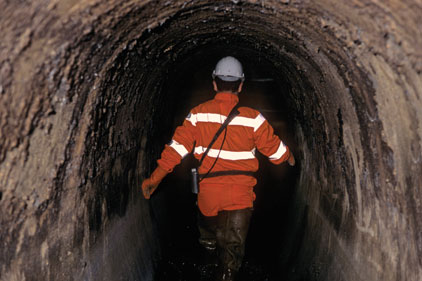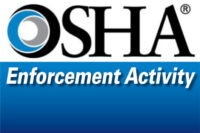Know your space
The institute’s investigations of confined space injuries and fatalities indicate that workers usually do not recognize that they are working in a confined space, so they may encounter unforeseen hazards. Testing and monitoring of the atmosphere is not performed, and rescue procedures are seldom planned. Site assessments will identify confined spaces, and ensure hazards are identified and required safety equipment is implemented.
Confined space hazards are not always obvious. Manholes, sewers, boilers, silos, vessels, tunnels, storage tanks, ship void spaces and underground vaults are easily identified as having limited means of entry or exit. Less obvious types of confined spaces can be overlooked but can be equally dangerous, such as open-topped water and degreaser tanks, open pits and enclosures with bottom access.
Monitor & ventilate
Indentifying a confined space is only the first step. Confined spaces could have an engulfment hazard, areas that could trap an entrant, exposed wires, unguarded machinery, heat stress or a combination of these or other hazards. Hazardous atmospheres are often overlooked. The atmosphere may not be hazardous immediately, but can become hazardous in a short span of time. Some atmospheric hazards can get to Immediately Dangerous to Life and Health (IDLH) levels quickly and are life-threatening. Before entry, a confined space should be monitored, at multiple levels, for all atmospheric hazards suspected to be present. The space should be ventilated and monitored continuously during work.
Common atmospheric hazards found in the work environment include:
- Oxygen deficiency: Exposure to atmospheres containing 12 percent or less oxygen can bring about unconsciousness without warning and so quickly that the individual cannot help or protect himself.
- Hydrogen sulfide exposure: Although the foul odor (rotten eggs) accompanies H2S at low concentrations, it is an unreliable warning because the gas rapidly desensitizes the olfactory (sense of smell) nerves and leads to a false sense of security. In high concentrations of H2S, a worker may collapse with little or no warning.
- Carbon monoxide exposure: Carbon monoxide is an odorless, colorless gas that may build up in a confined space. In high concentrations of carbon monoxide, a worker may collapse with little or no warning and thus be unable to aid himself.
Combustible gases within the LEL (lower explosive limit) and UEL (upper explosive limit): When fuel, oxygen and a source of ignition are present at the same time and in the right mixture, a serious explosion or fire is the result. If a combustible gas or vapor and air mixture is trapped in a confined space, only a source of ignition is necessary to create an explosion. Welding, sparking tools or even static electricity can easily satisfy this requirement.
Identifying atmospheric hazards is vital to maintaining safe work environments. Fixed and portable gas detection instruments are commonly used to identify the presence of atmospheric hazards. Instruments are typically used to detect the presence of toxic gases such as H2S and CO. For combustible gases such as methane or propane, instruments are often used to detect concentrations of gas up to the LEL. A gas-air mixture becomes explosive at the LEL, but the monitoring range of most instruments (0-100 percent of the LEL) is below this limit to provide advanced warning. Alarm levels may be set at 10 percent of the LEL to forewarn workers of a potentially hazardous combustible atmosphere.
Atmospheric hazards can originate from a variety of sources within the work environment, so it is important to understand common sources in order to develop appropriate safety plans and emergency response plans. Common sources of atmospheric hazards include: leaking gases and liquids; decomposing organic matter; combustion (welding, cutting, brazing) or oxidation (rusting); cleaning processes; oxygen enrichment; oxygen absorption; and combustible dust concentrations.
After checking for gases, the confined space should be properly ventilated to reduce the hazard level as much as possible. Proper attendants and rescue equipment should be in place before making any confined space entry or rescue.
Respiratory protection
If the confined space is or has the potential to be IDLH, workers must wear a tight-fitting positive pressure, air supplied respirator. A NIOSH-approved self-containing breathing apparatus (SCBA) or supplied-air respirator (SAR) with egress cylinder are the most appropriate respiratory protection options.
Grade D breathing air is provided to a worker wearing a supplied-air respirator (SAR) via a portable air cart, remote cylinders in a trailer or stored as plant breathing air, a Grade D breathing air compressor or filtered air from an industrial air compressor. The duration of a supplied-air respirator is limited to the capacity of the supplied air source. Because of the design of extended duration airlines, the possibility of the air source being interrupted requires that all supplied-air respirators used in IDLH situations include an egress cylinder providing enough Grade D breathing air to escape to a safe environment.
Other considerations
To maintain the safest possible work environment, always preplan your work by using your company’s confined space entry permit as a guideline. Below are additional items to consider:
Atmospheric testing and monitoring:
1) Fully understand the operation and calibration of your fixed and portable gas detection instruments
2) Zero your instrument in known fresh air prior to sampling for gases or vapors
3) Sample at various levels of a confined space — hazardous gases can settle at different heights based on weight
4) While working, sample continuously — conditions can change quickly.
Procedures:
1) Develop an initial work plan
2) Identify a standby person or attendant
3) Maintain constant communications/observation
4) Develop a rescue plan
5) Follow all established work processes and procedures.
Preparation:
1) Isolate/lockout/tag
2) Purge and ventilate
3) Follow all established cleaning processes
4) Follow all requirements for special equipment/tools
5) Follow all labeling and posting procedures as required
6) Identify appropriate respiratory protection, gas detection and personal protection equipment for the environment.
Rescue equipment: 1) Make available required rescue equipment per company policy and your rescue plan; 2) Inspect and maintain all rescue equipment per the requirements of your company safety plan.
Be proactive
While there are potentially many hazards associated with confined spaces, the right equipment and the correct safety precautions can go a long way to preventing injuries and fatalities. If questions arise, contact your site EHS manager, consult your company’s safety guidelines and review OSHA 1910.146 regulations for confined space.





